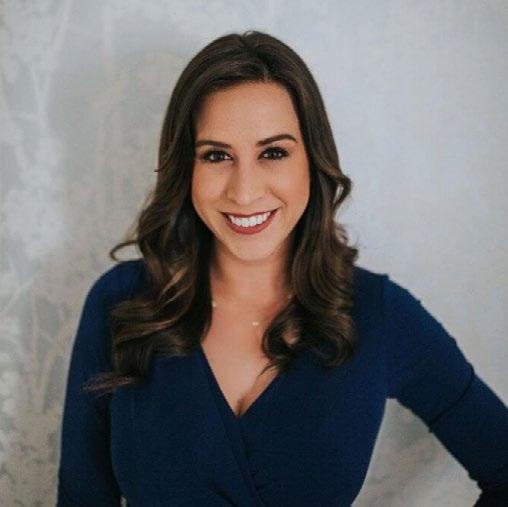TRANSITION VETERAN GUIDE 2022
LANDING YOUR POST-MILITARY JOB FROM
FILING VA CLAIMS


LANDING YOUR POST-MILITARY JOB FROM
FILING VA CLAIMS

I can’t begin to imagine the stress that comes with leaving the military. Between finding a permanent place to live and getting finances in order, to filing VA claims and making health care choices, the to-do list can be daunting. Here, we try to help with those decisions by providing tips and advice from experts and those who have experienced the transition firsthand, like Philip Berry, the subject of our cover story.
Philip had been on active duty in the Air Force for more than a decade before recently shifting into a reserve capacity. The move, he told writer Nikki Davidson, was beneficial for himself, his family and his wife’s career goals.

He is open and honest about what his experience was like, and we hope that his journey can ease some worries that you might have for your own pending transition.
We also walk you through ways to save money in preparation for your shift to full-time civilian life, what to look for when determining where to relocate and who to turn to if you want to file a VA claim but don’t know where to start.


What the articles can’t answer, the Veteran Service Organization directory can. There are dozens of groups with like-minded veterans who advocate on your behalf, know the ins and outs of the claims process and provide a safe, comfortable place to find camaraderie.
We don’t expect the information in these pages to relieve all of your anxieties, answer all of your questions or tell you everything you need to know. But we hope it’s a start.
 KARI WILLIAMS Associate Editor
KARI WILLIAMS Associate Editor
RYAN GUINA
Ryan Guina is the founder of TheMilitaryWallet.com and CashMoneyLife.com. He is a writer, small business owner and a military veteran. He currently serves in the Air National Guard.

NIKKI DAVIDSON
Nikki Davidson is a freelance multimedia storyteller who has worked for newspapers and TV stations across the country for 10 years. Emmynominated for her crime and political coverage, she has won multiple regional awards for her investigations into the health care system.




CRYSTAL KUPPER
Crystal Kupper is a writer, photographer, runner, mom of (at least) four and Air Force wife currently stationed in Arizona. There’s nowhere she’d rather be other than with her family or chatting about orphan justice.
KATE HORRELL
Kate Horrell is an Accredited Financial Counselor® and personal financial educator who helps the military community make the most of their pay and benefits. She shares the most upto-date information in understandable terms, and highlights how rules, programs and laws will directly impact your personal finances. With more than 10 years working with thousands of military families, she understands the concerns of currently serving, retired and veteran families.
Ashley Losoya is a freelance writer with a decade of experience in journalism, communications and content creation. She started her career as a television news reporter and anchor, working for NBC and CBS stations in Texas and California. After leaving the news business, Ashley served as communications director for the former lieutenant governor of Nevada. She is currently based in Arizona with her husband (an Air Force pilot) and two children.
 BY CRYSTAL KUPPER
BY CRYSTAL KUPPER
 BY KATE HORRELL
BY KATE HORRELL


When Master Sgt. Philip Berry returned home from his first activeduty Air Force deployment he had an important person to meet – his newborn daughter, Priscilla, who came into the world while he was away serving the country.
Up until his homecoming, he’d only seen his 3-month-old girl through Skype calls. Missing her birth was a sacrifice for both mother and father. His wife, Charna Berry, remembers holding their daughter at the airport, anxious for the two to finally meet.

“Just the anticipation of how (the baby) would respond to him, seeing him in person for the first time,” she recalled. “When he got off the plane and saw us and came to us, it was emotional. The one thing I remember thinking is, ‘Thank you, Lord, I’m glad he’s home safe.’ It was tough having him gone.”
That reunion was more than a decade ago. Now, after nearly 13 years of active-duty service, Philip is entering another new chapter. He’s transitioning from full-time airman to serving in the Air Force Reserve. It’s a choice he made to honor the sacrifices his wife and two children have made and to allow them to build a future in a permanent home.
“I didn’t want to put my kids through moving constantly,” Philip said. “My kids are finally making friends, and grandpa and grandma are an hour away and can see them every weekend.”
But most of all, he wanted to give his wife the same gift she gave him — the ability and support to pursue her dreams.
“My wife, she’s the reason I was so successful as I was active duty and why I probably have the job I have now because she decided to put so much into me,” he said. “And now that I’m not being dictated by the military, I can put some of that back into her.”
Finding a new purpose
Philip decided to join the reserves when he faced a looming PCS attached with a recent promotion. He made up his mind more than a year before the transition officially happened.
“If I didn’t have the amount of time I had, it would have been kind of more stressful,” he said. “I would say the timeframe and the amount of information that you get on the way out can be overwhelming for sure.”
The official recommendation from the Department of Defense is that service members start taking Transition Assistance Program (TAP) classes no less than two years before making the change.
It’s common for service members to feel rushed in the process. According to survey data compiled by the veteran community on Military-transition.org, more than half of people leaving active duty felt the transition took more time than expected, and 48% reported it was more difficult than anticipated.
Looking back, Philip wishes he would have known some things much earlier, especially the importance of a wellmaintained medical record.
“I feel like it’s kind of a secret until you get into those seminars or talk to someone who actually got out and was able to maximize their disability percentages,” he said. “I feel like a lot of veterans don’t find that out until the end, and then they’re fighting Veterans Affairs because they’re having to go to more appointments.”
Having served in the Air Force for more than four years, but less than 20, Philip is part of the military population considered 24% more likely by Military-transition.org to have a difficult time finding a job immediately at an expected income level.
He learned from TAP classes to prioritize LinkedIn as a networking tool. He ended up landing a job with a veteran-friendly employer, Amazon, as a human resources business partner three months before leaving activeduty status. It’s a job he feels he would never have gotten if he hadn’t utilized education benefits to finish a college degree.
“Get the education you can prior to getting out,” he suggested and noted that he applied for several jobs that required a four-year college degree. “Does that mean you’re not qualified if you don’t have it? No, but it is definitely something that will keep you out of the conversation.”
He admits working in the private sector comes with some challenges, but he’s found the culture at Amazon to be supportive and appreciates that several other veterans surround him.
Not ready to give up military life completely, Philip transitioned to the reserves. He was happy to continue
working toward retirement benefits and appreciated the ability to keep his family on the low-cost TRICARE Select health care plan.
The new flexibility, especially when living close to family, is something he enjoys. Instead of working for the military full time, he spends one weekend per month with his unit at Patrick Space Force Base, Florida, and will complete two weeks of annual training each year.
“The unit is definitely more of a family feel because a lot of people have been there for a long time,” he said. “In the reserves, it’s a little more predictable, and you get to know who your boss is, and those people have kind of roots in whatever area they’re in.”
“This is more of a balance that fits our life currently,” Charna said.
The Berrys faced a challenging housing market and moved quickly to find their new home.
“I’m a planner,” Charna said. “I have to be a few steps ahead when it comes to living situations.”
More than six months before the big move, the couple looked for a home, eventually selecting the small community of Davenport, Florida, to dodge nearby Tampa’s pricey housing market.

“The housing market made the process a little bit more challenging,” added Philip. “Fortunately for us, we had a good amount of time to find housing in advance of separation, and we encourage anyone making the transition to do their research and make moves in advance.”
After sacrificing many important moments together in the past dozen years, family time looks different for the Berrys now.
“With the transition from Phil being on active duty to reserves, it has allowed him to be more active and supportive in our daily lives,” Charna said. “He is able to attend our kids’ soccer practices, which has been really nice.
He wasn’t always able to make those types of things in the past.”
As there’s no longer the possibility of a PCS, she can also focus on her own career goals. Charna is now studying elementary education at St. Petersburg College while working as an instructional assistant in a local school district’s Exceptional Student Education resource department.
Philip enjoys the new freedom and control to carve out his path. He encourages others making the transition to reach out to other veterans for help and said there’s a
large community eager to support people making their next step.
“In the Air Force, you’re going to do what lines up with what the Air Force needs, not necessarily what Phil or Sgt. Berry desires or wants,” he said. “I can still go do my military service, but I feel like it’s more on my terms.”
Nearly 50% of veterans left their first post-military job within 12 months, according to a job retention survey from the Institute of Veterans and Military Families.
A lack of opportunities to apply their skills and abilities was cited as the most common reason.
Approximately 200,000 service members transition out of the military every year, making the adjustment to civilian life an important topic. Perhaps the most critical aspect of a successful transition is that first job placement.
If you can find a career you’re passionate about, it will make all the difference, and experts say the job market is exceptionally good right now.
Here are three ways to simplify the process.
Work with a recruiting agency Marine veteran Bob Berkholz, who has worked as a recruiter with Orion Talent for 25 years, said that in the current market, those with “decent flexibility” in their geographical parameters could be placed in a job within a few weeks.
While this timeline can vary depending on your military specialty,
Berkholz said working with a recruiting agency can make all the difference. In fact, he landed his first position at Orion Talent through one of the 75+ hiring conferences the company hosts annually.


“I would tell veterans to exercise their options in the job market and take advantage of a firm like ours to showcase your skillset,” Berkholz said. “We can assist them with so many different tools and make the transition much more effective and enjoyable.”
In many cases, it takes the stress out of the job search. Plus, it can increase chances of longevity.
“It may establish a longer career path if you’re matched up with the right company,” he said.
Take a professional assessment test In addition to working with a recruiter, Berkholz emphasized the importance of planning ahead.
“Don’t wait until you’re 30 days from separation to plan your transition,” he said. “This needs to be something you’re thinking about in advance.”
For Ben Adams, a Navy veteran who spent years planning his transition, this was critical to his success.
“You have to take time to peel back the onion,” Adams said. “It starts with knowing yourself. If you don’t know yourself, you don’t understand your weaknesses and passions.”
Today, Adams works for Amazon as a human resources business partner, a role he knew would be a great fit after taking several professional assessments. He typically recommends CareerLeader and the CliftonStrengths Assessment as key resources in this specific area.
Adams said many of the transitioning service members he assists are surprised by their assessment results.
“These tests align with their passions and strengths, but they have nothing to do with what they thought they wanted to do,” he said.
At the end of the day, Adams said, assessments make a difference when it comes to finding a career you love, versus simply finding a job.
Lean into a mentor
While statistics around the subject vary, most people agree that “who you know” is a large part of the equation. Finding a mentor to coach you (and potentially connect you) might impact your marketability.
From building your resume to preparing for interview questions, a mentor can help you make the right choice when it counts the most. For Adams, a mentor in the HR field was there to help him tailor his resume to reflect relatable military experience.
“She helped coach me and encourage me,” he said. “Whether you’re going into oil or finance, you have to be able to articulate it, and they can help.”
For Adams, it took a dozen applications to land his first interview, but he was never discouraged.
“It’s a journey, and everyone’s journey is uniquely different,” he said.
As for advice after a successful transition is made, Adams reminds veterans to keep others in mind and pay it forward.
 BY CRYSTAL KUPPER
BY CRYSTAL KUPPER
When Cpl. Steven Wolf left the Marines in 1997, he had no idea what Veterans Affairs (VA) was –or that he was eligible to receive monetary compensation for his military-related injuries.
Now, as the assistant national service director for Disabled American Veterans (DAV), Wolf makes his living making sure that other veterans do not walk that same road alone.
“Filing a VA claim after you get out of the military and have injuries can be very overwhelming and confusing,” Wolf said. “There is a lot of paperwork and questions you might have, so it can be daunting.”
Service officers assist with claims
For generations, VA has had a disability-compensation program that sends monthly tax-free checks to veterans who became ill or injured during their time in service, or whose existing condition worsened. The amount varies based on disability level, a rating determined by VA standards. In order to access this stipend, one must file a VA claim. And once that claim reaches VA, the process, as of January 2022, takes almost 161 days of waiting.
A veteran cannot receive VA compensation without filing a successful claim first. DAV helps more than 160,000 veterans file them each year through its network of national
service officers. Claims can range from PTSD and tinnitus (the most common claim, according to VA reports) to migraines and nerve damage. There is neither a limit to the number of times someone can file claims nor an expiration date on eligibility.
“If you don’t have someone who can help you with filing your first VA claim, it can be like filing your taxes with no help, because you just don’t know how,” Wolf said. “It’s a mountain of confusing paperwork, but DAV officers assist you at the beginning, during and post, so it’s kind of for life.”
Other VSOs, such as Veterans of Foreign Wars and the American Legion, also have service officers at
locations throughout the country to help veterans file claims.
The process, on its face, is fairly straightforward. If a veteran thinks he or she has a service-connected disability, they begin gathering documents to prove their claim: health care records, photographs, witness statements to corroborate the claim(s), their DD-214 form, etc. They next fill out certain VA forms and wait for approval or disapproval. Appeals are allowed, and officers from several VSOs are usually trained – and even accredited – to help in the process.
AMVETS, a VSO that began in 1944 to help World War II vets navigate government benefits, is among them. Miles Migliara, AMVETS chief communications officer, said his organization aims to make sure
no eligible veteran goes without a deserved VA benefit.
“AMVETS service officers are trained to ask a veteran the right questions concerning a claim, lay out exactly what a veteran is eligible for and guide them through what is sometimes perceived as a long, frustrating process,” he said. “We want veterans to enjoy using VA, getting help from AMVETS, and most of all, get the process of filing claims out of the way so they can focus on living their best lives.”

More than 5 million veterans and survivors currently receive VA benefits. In 2018 alone, VA paid more than $91 billion. Though the COVID-19 pandemic has slowed the process slightly, Migliara said AMVETS pivoted quickly.
“We have embraced telecommunication as a way to keep services flowing,” he said. “We’ve also taken extra measures to keep our website updated with the most current information and resources veterans and service officers can use.”
Wolf is currently helping around 100 veterans personally with their VA claims. The most important thing he emphasized? Don’t do it alone.
“When you get out, you get your Transistion Assistance Program, but they may not go into every single thing like VA claims,” he said. “So it’s good to have someone to talk to who has been there.”
For more information, or to locate an accredited service officer, visit https://www.va.gov/ogc/apps/ accreditation/index.asp.
Jobs and careers are among the main concerns for service members looking to relocate as they leave the military, according to Jessica Brutzman, a realtor and certified military relocation professional in Traverse City, Michigan.

And when Holly Coleman’s husband, Michael, retired in May 2021, that proved to be the case when they moved from Mountain Home Air Force Base in Idaho to western Washington state.
“My husband is in tech; I’m in health care,” she said. “We knew this area would be the best place financially for us. And it is. We’re making way more now than we ever did while he was active duty.”
While everyone’s priorities differ, items to consider include:
Proximity to, or distance from, family;
Jobs for one or both spouses; Schools, for children or adults; Access to beaches, mountains, rivers or lakes; Cultural opportunities; Distance from airport; Weather; Cost of living;
Big city vs. suburbs vs. rural; Taxes; Political climate;
Access to VA facilities; For retirees, access to military facilities.
For those with children, schools are a big consideration, ranging from special needs resources to athletics or a particular high school experience.
“My son goes to a mini college for high school,” Coleman said. “He wants to go into tech and being in western Washington, one of the tech meccas of our country, this is his best chance.”
Being able to enjoy a particular lifestyle is also easier to accomplish when picking your own location. Personal budgets are a driving factor as well.
“Be sure to understand your budget so you can maximize your options in whichever state you choose,” Brutzman said.
Those who plan to work should also ensure that local salaries make sense for the cost of living. If retiring, confirm that you can maintain the standard of living you want on the income you’ll have. Picking the right location can make all those parts come together.
Keep in mind that your new “permanent” home may not be quite so permanent. Thinking of your first
post-military location as just another duty station can take some of the pressure out of the decision. There’s no rule that you have to stay there.
QUIZ:
Finding your post-military home can be a fun part of the transition from military to civilian life. By prioritizing the things that are important to you, you’ll increase the chances that you have a good fit for your next adventure.
1. Are you or your spouse planning to work?
2. Do you have school-aged children?
3. What type of lifestyle do you want?
4. What is your budget?


Many veterans face financial challenges during their military transition, but careful planning can ease the process. Be aware that it takes time to adjust spending patterns and save the money you need during your transition.
Review your budget to understand how your transition will impact your expenses. According to the Bureau of Labor Statistics, Americans’ largest expenses are housing, food, transportation and health care.
Two of these expenses might be directly impacted by leaving military service. For example, will you lose access to base housing? Will you have continued access to TRICARE, or will you need to find an alternative?
Run the numbers to have a realistic understanding of how these expenses might change.


You may face one-time expenses after leaving the military, such as additional moving costs beyond what the military provides or purchasing a professional wardrobe or new gear for your civilian job. Other examples include rental or utility deposits, down payment on a house, travel, tuition or related expenses.
These actions work in tandem to improve your situation. You might be able to generate extra income by consulting, taking a part-time job, working in the gig economy or even applying for unemployment.
Reducing expenses eases the demand on your finite funds. But instead of focusing on cutting the occasional latte, you’ll get quicker results by trimming your highest costs, such as housing, food and transportation.
Debt reduction is powerful. Decreasing your monthly expenses reduces your monthly footprint and allows you to have a smaller emergency fund.
Which debt to tackle first? There are two schools of thought: Mathematically, paying extra toward the debt with the highest interest rate will give you the best overall return. However, paying off your lowest balance first gives you momentum and an emotional win.

Your emergency fund protects you from unexpected expenses. Many financial experts recommend saving three to six months of expenses in your rainy day fund. However, you might feel comfortable with more or less, depending on your situation.
The first step in preparing a battle plan is understanding your objectives. The same thing applies to your post-military finances. You can start preparing for the transition now that you have a good idea of your future expenses.
Work backward to determine how much you need to save. Start with your bare-bones living expenses (rent/ mortgage, food, utilities, loans, other regular bills), then consider how long you would feel comfortable going without income. Multiply that by your bare-bones expenses to come up with your number.
Even if you don’t reach your savings goal before your separation date, any savings are helpful.
Paying off your smallest debt first also removes one of your fixed bills each month. Having one less payment allows you to scale back if necessary or redirect that payment amount to your next smallest bill, helping you to repay it more quickly. This is the Debt Snowball method, popularized by Dave Ramsey.
Leaving the military is full of unknowns, and perfect planning simply isn’t possible. Don’t be hard on yourself when unanticipated situations arise –because they will. These unforeseen situations illustrate why having a buffer is essential. If possible, add 5% to 10% to the numbers you arrived at earlier. This buffer gives you wiggle room when these unanticipated situations arise.
 BY KARI WILLIAMS | SPONSORED CONTENT
BY KARI WILLIAMS | SPONSORED CONTENT
“It’s something you can put in your drawer and not have to worry about every day,” said Connie Markovich, president and CEO of USBA.
Since its inception in 1959, USBA’s primary target has been serving the military population. At the time, group life insurance for the military maxed out at $10,000 and didn’t include coverage for the service member’s family.
While that has since increased to $400,000, service members lose the
benefit – Servicemembers’ Group Life Insurance (SGLI) – four months after leaving the service.
“At that point, early on, we had just a decreasing term product,” Markovich said. “You could get up to $50,000 in the beginning. Then those amounts increased; we added different products over time and expanded from just active duty and retirees to include federal employees and veterans.”
Nobody wants to think about life insurance, but once it’s secured, it brings a peace of mind.
When exiting the service, SGLI options are limited. After that, Veterans’ Group Life Insurance (VGLI) is the next VA option, but the premium increases every five years, whereas USBA offers several alternatives with premiums projected to remain level for longer terms.
USBA offers 5-, 10-, 15- and 20year level term plans, meaning the benefit amount service members are insured for remains constant for the stated time period. Under the 10-year level term, policy coverage ranges from $25,000 to $500,000 based on a family’s needs.
“The premium is projected to stay level over that same term,” Markovich said, “but unlike higher priced whole life insurance options, term rates are not guaranteed.”
USBA’s most popular plan, according to Markovich, is their 15-year level term plan because pricing is “right in the middle” of other term plans. The 20-year’s term has increased in popularity over the years.
With all of USBA’s level term plans, the benefit amount remains level for the length of the contract, and premiums are expected to remain level over the specified term.
One of USBA’s more unique offerings is its two-for-one policy, which insures both spouses under one policy and premium. The policy pays on the first person to die, while the other has the option to continue coverage. If both die in the same accident, the policy pays on both.
“Many couples like that security and the convenience of having one policy, one premium, rather than two,” she said. “It is a very popular plan.”
However, Markovich said that in the event of a divorce, each person can continue their coverage under the 5-year level term plan, or they may be able to apply for a different plan altogether. Depending on their health at the time, several competitive options are available.

USBA also offers whole-life options, accidental death policies, a hospital indemnity plan and TRICARE supplements, as well as the decreasing-term policy it has offered since the company’s founding.
Service members should begin looking into post-military life insurance coverage as soon as they start thinking about leaving the service, according to Markovich, for two key reasons.
First, life insurance is based on current age at the time the insurance is issued. So regardless of the type of policy, the older a person is, the higher their premium will be for that same coverage. The other factor is one’s health.
“You never know what’s going to happen down the road,” Markovich said. “The earlier you secure coverage, you’re securing it at a lower rate per thousand than if you’d waited another year … while your health is good – at least that’s the hope.”
In researching what policy will best fit the individual, USBA provides a coverage estimator on its website – a feature that Markovich said has proven to be “helpful, perhaps critical, for those who don’t know where to start.”
“A lot of people don’t want to call somebody,” she said. “There’s a healthy segment of the population that kind of wants to do their own thing and hop on a website.”
The estimator allows customers to determine coverage amounts based on how much they want to pay per month or what type of insurance they can apply for based on the amount they’re willing to pay.
Markovich said it’s important not to let too much time pass between getting out of the service and securing life insurance. Even for people who are young and single.
“It’s not just for married people, and it’s not just for older people,” Markovich said. “Even if you’re young and single – and many are staying single longer now – you still have things like your mortgage, your college loans and credit card debt, obligations you don’t want to pass on to your parents or other loved ones.”
There’s the misconception, she said, that being young and single means life insurance isn’t necessary.
“But there’s often someone who will be responsible for your debts,” Markovich said. “No matter if you’re young or old, married or single, life insurance can help bring peace of mind.”
Life after military service can present challenges like finding a job, going back to school, navigating benefits, and even finding others who understand your story. Veteran Service Organizations (VSOs) can help service members before, during and after the transition process.
Some provide help filing claims with the Department of Veterans Affairs, some lobby Congress to maintain or extend benefits and others offer networking opportunities and camaraderie.
The American Freedom Fund
Based in Washington, D.C., the American Freedom Fund supports veterans with outdoor sporting activities, including softball and shooting. Twice-monthly, R.E.D. Friday events bring together supporters to enjoy camaraderie while Remembering Everyone Deployed. Lastly, AFF helps veterans and military spouses transition to civilian employment through headshot events with professional photographers and wardrobe consultants.
The American Legion
The American Legion, the largest wartime veterans service organization, provides local and national activities that focus on strengthening communities with diverse programming. Events range from youth baseball and oratorical competitions to shooting sports. American Legion Posts also employ veteran service officers who help veterans and their families navigate their benefits, including VA’s disability process. Many American Legion locations have physical clubs where veterans and their families can spend time with each other, whether watching a movie, going for a run or sharing a meal.
AMVETS
AMVETS National Service Foundation is the nation’s most inclusive VSO, as it is open to anyone who has served. AMVETS’ largest program is the National Service Officers, who help veterans through VA’s disability
process. Other AMVETS programs include thrift stores, scholarships and service in VA hospitals.
Blinded Veterans Association
Chartered in March 1945, Blinded Veterans Association is the sole congressionally chartered VSO for and by visually impaired service members. Its goal is to advocate for and mentor veterans – and their relatives – whose sight has been affected by their military service.
Bunker Labs
Bunker Labs supports transitioning service members and veterans through their entrepreneurship journey. Programs include Launch Lab Online, WeWork Veterans in Residence and CEOcircle.
Catholic War Veterans and Auxiliary
Incorporated in New York in 1935, the Catholic War Veterans and Auxiliary is one of the oldest VSOs in existence. In addition to its advocacy, the organization also offers scholarships and provides service officers at no cost to help veterans with federal benefit claims.
Corporate America Supports You/ VetJobs


Corporate American Supports You connects military and veteran jobs seekers with employers who are looking to hire veterans. Support includes job readiness assessment, referral to training or education programs, resume writing and matching with specific, available jobs from an extensive job listing service.
Disabled American Veterans
Disabled American Veterans provides a nationwide network of support for disabled veterans through communitybased chapters, in-hospital service coordination offices, regional transition service offices and mobile offices serving veterans in rural areas. Specific programs include rides to VA medical facilities, free informational meetings about VA benefits and assistance filing VA benefit claims.
Fleet Reserve Association
The Fleet Reserve Association’s programs support veterans by fighting
for benefits in Congress. Accurate and up-to-date benefit information is disseminated through the FRAToday magazine. The FRA sponsors a large college scholarship program, an Americanism essay contest and a disaster relief fund to aid victims of natural disasters.
Gold Star Wives of America
Gold Star Wives of America assists those who have lost a loved one in the line of duty while serving in any conflict the U.S. has been involved in. Membership includes the widow, as well as parents of fallen service members, regardless of rank, race or creed.
Hire Heroes USA
Hire Heroes USA provides free, personalized career coaching, mentoring and job search assistance. Specific help includes resume writing, mock interviews, virtual and in-person career fairs, and webinars on topics such as networking and finding a federal job.
Hiring Our Heroes
Hiring Our Heroes, an initiative of the U.S. Chamber of Commerce, connects military members, veterans and military spouses with employment opportunities. To accomplish that goal, Hiring Our Heroes offers a variety of digital tools, including a resume builder and a jobs portal.
IVMF, hosted at Syracuse University, offers a broad portfolio of employment and entrepreneurship support to service members, veterans and spouses in employment and entrepreneurship. Signature programs include Onward to Opportunity career and certification training and nine different entrepreneurship tracks.
Less than 20 years old, Iraq and Afghanistan Veterans of America provides transition assistance focusing on mental health, health care and GI Bill benefits. Programs include
VetTogether, bringing Post-9/11 veterans together with local-area events, and the Rapid Response Referral Program — providing hightech, high-touch case management and referral services. Veteran transition managers connect veterans with governmental and non-governmental programs, benefits and services.
Jewish War Veterans of the United States of America
Jewish War Veterans of the United States of America helps service members reacclimate to the Jewish community and access VA benefits. The organization also works to fight against anti-Semitism in the military and in VA. It also works with several youth programs and advocates on Capitol Hill on behalf of its members.
Marine Corps League
The Marine Corps League programs include wounded warrior support, youth programming and veteran benefits. The Marine Corps League also founded and maintains the well-known Toys for Tots program that provides Christmas presents to underprivileged families.
The Military Officers Association of America is a powerful lobbying group dedicated to tackling important issues facing the military and veteran communities. It also offers career services, educational support, and pay and benefits information. Regular newsletters and its print magazine keep members informed about the most important issues before Congress and the Department of Defense.
Military Order of the Purple Heart Open exclusively to those who have been awarded a Purple Heart, this organization provides disability claims assistance and scholarship opportunities to veterans and their eligible family members. Outreach programs include VA’s Volunteer Service Program, youth programs like JROTC support and community Americanism program.
The National Association of Black Veterans advocates on behalf of its members with the goal of having 50% of Black veterans among its
membership and establishing departments and councils nationwide. NABVETS intends to connect with recently separated service members, as well as those on active duty.
National Veterans Legal Services Program was founded in 1981 to advocate for service members to receive the benefits they’re owed. NVLSP works with the Military Order of the Purple Heart, Vietnam Veterans of America and MOAA to keep volunteers and fellow advocates up to date on laws and advocacy techniques.
Paralyzed Veterans of America
Paralyzed Veterans of America has supported disabled and paralyzed service members for more than a quarter century. Its cornerstones include advocating for quality health care; research and education on spinal cord injuries; military-related benefits; and civil rights.
Patriot Boot Camp
Patriot Boot Camp offers veterans, spouses and current-serving military members with a variety of entrepreneurship resources. Three-day camps include mentoring sessions, networking and skills development. PBC alums support each other as their businesses grow.
Student Veterans of America
Student Veterans of America provides veterans with the resources they need to succeed in higher education and post-graduation employment. Through local chapters, scholarships, and leadership training, it improves the student veteran experience. Research and lobbying efforts help protect military educational benefits from changes and cutbacks.
Team Red, White & Blue
Team RWB builds community through fitness and wellness activities such as group runs, yoga and bike rides. Members build friendships and workout their stress in the company of other veterans.
Team Rubicon
Team Rubicon helps veterans connect and find a new purpose with bootson-the-ground disaster assistance. The organization’s “deployments” gives
veterans a place to connect with other vets and find a new purpose.
The Boot Campaign
The Boot Campaign works across the country to help veterans find and pay for evidence-based medical and mental health care. Through their networks, providers and veterans can work together to create and implement plans for recovery from the invisible wounds of war.
Veterans Campaign
Veterans Campaign provides the military community with the tools and guidance to run for public office. Support includes training workshops, networking opportunities, conferences, research and a “field manual.”
The Veterans of Foreign Wars (VFW) is a powerful lobbying and benefit resource organization providing assistance through the Unmet Needs Program, the Sport Clips Help a Hero Scholarship and other benefits claims work, grants and scholarships. Physical clubs provide a place for veterans and their families to socialize with people who understand their experiences.
Veterati


Veterati connects transitioning service members, veterans and spouses with experienced mentors for one-hour phone calls. Mentors can help with navigating networking, interviewing, salary negotiation and the realities of working in the civilian world.
Vietnam Veterans of America
Vietnam Veterans of America’s motto is “Helping veterans, communities, and those serving in harm’s way.” The organization fulfills its mission with a wide variety of veteran services, public outreach and veterans’ advocacy projects. In particular, their service officers help veterans prepare disability claims.
Wounded Warrior Project
Wounded Warrior Project supports the special needs of injured veterans. WWP has more than a dozen programs ranging from the Combat Stress Recovery Program to career assistance to free, telephonic, nonclinical talk therapy for registered veterans, family members and caregivers.


